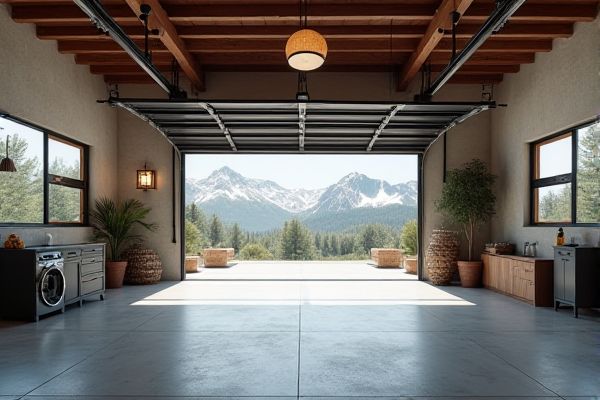
A temperature-controlled garage maintains consistent climate levels to protect your vehicle and belongings from extreme heat, cold, and humidity, while a standard garage lacks this feature, often leading to potential damage from fluctuating temperatures. Discover how choosing the right garage can extend the life of your investments by reading the rest of the article.
Table of Comparison
| Feature | Temperature-Controlled Garage | Standard Garage |
|---|---|---|
| Temperature Regulation | Maintains consistent temperature year-round (typically 55degF-75degF) | No temperature control; subject to external weather conditions |
| Energy Efficiency | Higher energy use due to heating/cooling systems | Lower energy usage, no HVAC installed |
| Vehicle Protection | Prevents damage from extreme temperatures, reduces wear and tear | Exposed to temperature fluctuations, potential for condensation and rust |
| Storage Suitability | Ideal for sensitive items (paint, electronics, antiques) | Limited protection for sensitive storage items |
| Cost | Higher construction and operating costs | Lower construction and operating costs |
| Comfort | Comfortable working environment year-round | Uncomfortable in extreme weather |
Introduction to Garage Types
A temperature-controlled garage maintains a consistent climate using insulation, heating, and cooling systems, protecting vehicles and stored items from extreme temperatures and humidity. Standard garages lack these features, resulting in fluctuating temperatures that can cause damage to delicate materials and reduce vehicle lifespan. Choosing a temperature-controlled garage enhances preservation of automobiles, prevents condensation-related issues, and increases overall comfort for users.
What is a Temperature-Controlled Garage?
A temperature-controlled garage maintains a consistent climate by regulating heat and humidity through insulation, heating, and cooling systems, preventing damage to vehicles and stored items caused by extreme temperatures. Unlike a standard garage, which lacks climate control and allows temperature fluctuations, a temperature-controlled space protects your car's paint, battery, and interior from cracking or fading. Investing in a temperature-controlled garage extends the lifespan of your vehicle and preserves sensitive belongings from moisture and temperature-related deterioration.
Features of a Standard Garage
A standard garage typically features basic insulation, concrete flooring, and manual or automatic garage doors without climate regulation systems. It offers protection from weather and theft but lacks temperature control, leading to fluctuations that may impact stored items and vehicle comfort. You may notice increased energy inefficiency and potential condensation issues compared to a temperature-controlled garage.
Temperature Regulation and Climate Control
A temperature-controlled garage uses advanced HVAC systems to maintain consistent temperatures, protecting your vehicles and stored items from extreme heat, cold, and humidity fluctuations. Standard garages lack climate control, leaving your belongings vulnerable to condensation, freezing, and heat damage, which can shorten their lifespan. Ensuring your garage is temperature-controlled improves preservation efficiency and provides a more comfortable environment for any projects you undertake.
Energy Efficiency and Insulation
Temperature-controlled garages maintain consistent indoor temperatures through advanced insulation materials and efficient HVAC systems, significantly reducing energy loss compared to standard garages. Enhanced insulation in temperature-controlled garages minimizes heat transfer, leading to lower energy consumption and cost savings. Your energy bills benefit from the improved thermal regulation, making temperature-controlled garages a more sustainable and efficient choice.
Vehicle and Belonging Protection
Temperature-controlled garages maintain consistent indoor climates, preventing extreme heat or cold that can damage vehicle engines, batteries, and interior materials. These garages also protect belongings from moisture buildup and mold growth, which are common in standard garages lacking temperature regulation. This controlled environment extends the lifespan of stored items and ensures vehicles remain in optimal condition year-round.
Cost Comparison: Installation and Maintenance
Temperature-controlled garages typically involve higher installation costs due to the need for insulation, HVAC systems, and specialized materials to regulate temperature effectively. Maintenance expenses for temperature-controlled garages also tend to be greater, as heating and cooling systems require regular servicing and energy consumption increases utility bills. In contrast, standard garages have lower upfront installation costs and minimal maintenance, though they lack temperature regulation benefits.
Comfort and Usability Year-Round
Temperature-controlled garages maintain consistent indoor climate, enhancing comfort by preventing extreme heat or cold, making the space usable year-round for projects, storage, or parking. Standard garages often experience temperature fluctuations, limiting usability especially during harsh winters or summer heat. Investing in insulation, heating, or cooling systems in temperature-controlled garages maximizes functionality and protects stored items from weather-related damage.
Impact on Home Value and Resale
A temperature-controlled garage significantly enhances your home's value by protecting vehicles and stored items from extreme temperatures, reducing wear and maintenance costs. Buyers often perceive temperature-controlled garages as a premium feature, increasing resale appeal and potentially leading to a quicker sale at a higher price. In contrast, standard garages offer basic shelter but lack climate regulation, which may be less attractive to discerning buyers concerned about long-term durability and comfort.
Choosing the Right Garage for Your Needs
Temperature-controlled garages maintain consistent climates, preventing extreme heat, cold, and humidity fluctuations that can damage vehicles, stored items, and tools. Standard garages, while cost-effective, lack insulation and climate regulation, leading to potential issues like condensation, rust, and wear on sensitive equipment. Selecting a temperature-controlled garage is ideal for those prioritizing long-term protection and preservation of valuable assets in varying climates.
 homyna.com
homyna.com